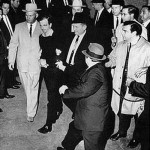Fifty years ago this November 22, President John Fitzgerald Kennedy, was fatally shot and killed in the city of Dallas, Texas. The assassination had an effect on many people, not only in the United States, but around the world. Many vividly remember where they were when first hearing of the news that Kennedy had been assassinated. To this day, many believe that the assassination of Kennedy was a conspiracy and many questions remain unanswered.
John Kennedy was born in Brookline, Massachusetts on May, 29, 1917. Serving in the U.S. Navy during World War II, Kennedy was a commander of PT boats, which were small fast attack boats. On August 2, 1943, Kennedy’s boat, PT-109, was on a patrol near the Solomon Islands in the Pacific Ocean, when it was rammed and sunk by a Japanese destroyer. Kennedy gathered his surviving crew members together in the water and they swam towards a small island. Kennedy, despite an injury to his back in the collision, towed a badly burned crewman to the island with a life jacket strap clenched between his teeth, then to another island from where his crew was subsequently rescued. For these actions, Kennedy received the Navy and Marine Corps Medal. Kennedy continued serving in PT boats after this ordeal and was honorably discharged in 1945.
Kennedy’s political career began when he was elected in 1946 as a Congressman to represent the Massachusetts 11th District in the U.S. House of Representatives where he served for six years. In 1952 he was elected to the U.S. Senate as one of the two U.S. Senators from Massachusetts. Running for President on the Democratic ticket in the 1960 Presidential Election, Kennedy won the primary and then beat the Republican Presidential candidate Richard Nixon to become the 35th President of the United States. Kennedy was sworn in as President on January 20, 1961, his Vice-President was former Texas Senator Lyndon B. Johnson. In his inaugural address he spoke of the need for all Americans to be active citizens, famously saying, “Ask not what your country can do for you; ask what you can do for your country.”
Kennedy’s Presidency was marked by several important events, some of which involved Cuba. (In 1959 Fidel Castro had become the leader of Cuba after the Cuban Revolution and had installed a Communist Government) These included the failed “Bay of Pigs” invasion of Cuba by CIA trained anti-Castro exiles and the “Cuban Missile Crisis” where the Soviet Union placed land-based nuclear missiles in Cuba 90 miles from Florida.
President Kennedy was influential in Civil Rights and helped to establish the Peace Corps. President Kennedy’s brother, Robert, who was Attorney General of the United States, relentlessly pursued organized crime and the mafia. The Kennedy Presidency was also known for an increase in U.S. Military involvement in Vietnam that eventually led to the Vietnam War.
On Friday November 22, 1963, President Kennedy arrived in Dallas for a visit and was traveling in an open-topped limousine with his wife Jacqueline, Texas Governor John Connally, Connally’s wife Nellie, and two Secret Service Agents. Other vehicles in the motorcade carried more Secret Service Agents, Police Officers, Vice-President Lyndon Johnson, and several local officials. People in Dallas lined the streets along the motorcade route for an opportunity to see the President. At 12:29 pm, as the motorcade entered Dealey Plaza and made a planned turn passing in front of the Texas School Book Depository Building, three shots were fired at the President as they continued down the street. Kennedy was shot twice, first in the upper back, then in the head. Governor Connally was also shot in the back with the bullet exiting his chest and entering his wrist. A bystander on the sidewalk, James Tague, was hit by bullet fragments from a bullet that hit the road. The limousine then raced to Parkland Hospital where President Kennedy died despite efforts to save his life and Governor Connally was rushed into emergency surgery.
During a search for the shooter a rifle was found on the 6th floor of the Texas School Book Depository Building. The rifle was a World War II Italian military rifle; a 1940 Carcano 6.5mm caliber bolt action rifle with a scope mounted on it. Also found nearby were three 6.5mm cartridge cases that appeared to have been fired from the rifle. A supervisor at the Depository eventually reported that one of his employees was missing; Lee Harvey Oswald.
Lee Harvey Oswald was born in New Orleans in 1939, his father dying two months before he was born. Oswald had two older brothers and his mother moved the family several times during Oswald’s childhood; to Dallas, then to New York City, then later back to New Orleans. As a child, Oswald was described by several people who knew him as withdrawn and temperamental. After a troubled childhood Oswald joined the Marine Corps when he was seventeen years old where he was trained to be a radio operator. Like all Marines, Oswald received training in shooting a rifle and was qualified as a sharpshooter. Oswald also attempted to learn the Russian language while in the Marines.
In 1959 Oswald received a hardship discharge from active service, claiming his mother needed care, and was put on reserve. He then traveled to the Soviet Union, renounced his U.S. citizenship, and defected to the Soviet Union. Although he wished to attend Moscow University, Oswald was sent to the city of Minsk to work in an electronics factory. There he met Marina Nikolayevna Prusakova; they got married on April 30, 1961 and later had a daughter. Oswald eventually grew bored with life in the Soviet Union and applied at the U.S. Embassy in Moscow to return to the United States.
In 1962 Oswald with his wife and daughter returned to the States settling in the Dallas/Fort Worth area. In early 1963 he purchased a surplus Italian Carcano 6.5mm rifle with a 4x scope and a used Smith & Wesson .38 revolver by mail order using false identification. (ordering guns through the mail was legal until 1968) Oswald moved his family to New Orleans in April 1963 where he joined the “Fair Play for Cuba Committee”, whose stated purpose was to provide support for Communist Cuba against the United States. In August, Oswald was arrested in downtown New Orleans for disturbing the peace because he got into a fight while passing out leaflets in an incident which was filmed by a local TV station. Sometime afterwards, Oswald’s wife Marina traveled with her daughter to stay at a friend’s house in Irving, Texas, while Oswald left for Mexico City in September where he unsuccessfully tried to get a visa from the Cuban Embassy to visit Cuba.
In October, Oswald returned to Texas where he got a job in the Texas School Book Depository. Catching a ride to work on the morning of November 22, he had a long brown paper package; he told the driver that the package contained curtain rods. Oswald was seen working on the sixth floor of the Depository which was mostly used for storage and contained many large boxes. Oswald is believed to have opened a corner window and shot at Kennedy as the Presidential limousine passed by the window. Leaving the rifle behind he managed to escape despite being questioned by a Police Officer who had entered the building to search for a possible shooter. Several witnesses across the street had seen a man in a window shoot a rifle at the President and a basic description of Oswald was sent out to the Police.
Sometime afterwards, Dallas Police Officer J. D. Tippit spotted Oswald walking down a sidewalk and drove up in his patrol car because he resembled the description of the man seen firing the shots at the President. Tippit apparently questioned Oswald from his car window, then exited the car and was shot and killed by four shots from Oswald’s S&W revolver. Several witnesses heard the shots and saw Oswald fleeing the scene with a gun. Oswald ran up the street and managed to slip into the nearby Texas Theatre without paying but he was seen by a ticket clerk who telephoned the police. Oswald was captured after a struggle and as he was led from the theater, Oswald shouted he was a victim of police brutality. Oswald was taken to Dallas Police Headquarters where he was questioned about the shooting of Officer Tippit. When a Police Captain heard Oswald’s name, he recognized it as that of the Book Depository employee who was reported missing and was already a suspect in the assassination. After his capture Oswald was seen by reporters while being taken down a hallway. Oswald yelled: “I didn’t shoot anybody, they’ve taken me in because of the fact that I lived in the Soviet Union. I’m just a patsy!”
Oswald was interrogated several times during his two days at Dallas Police Headquarters. He denied killing President Kennedy and Officer Tippit, denied owning a rifle, and denied carrying a long package to work the morning of the assassination. On Sunday November 24, as Oswald was being led through the basement of Dallas Police Headquarters for his transfer to the County jail. A man named Jack Ruby stepped from the crowd and shot Oswald in the chest.

Ruby about to shoot Oswald who is being escorted by Dallas poilce detectives two days after Kennedy was killed.
Television cameras, there to cover the transfer of Oswald, was broadcasting live, and millions witnessed the shooting on television as it happened. Oswald was rushed to Parkland Hospital, the same hospital where President Kennedy was taken two days earlier. The doctors, despite their best efforts, were unsuccessful and Oswald died.
Jack Ruby was a local nightclub owner originally from Chicago who had moved to Dallas in 1947. Ruby had several nightclubs and had become friends with many Dallas police officers who frequented his clubs and was also friendly with members of the local media. As a result, his presence at Police Headquarters when Oswald was being transferred had raised no alarm. Ruby was also known to have had ties with the mafia.
Jack Ruby was arrested immediately after the shooting of Oswald. He said that he had helped the city of Dallas “redeem” itself in the eyes of the public, and that Oswald’s death would spare “Mrs. Kennedy the discomfort of coming back for a trial”. Ruby was put on trial and on March 14, 1964, Ruby was convicted of murder with malice, for which he received a death sentence. In December of 1966, Ruby was admitted to the hospital where doctors found that he had cancer in his liver, lungs, and brain. He died on January 3, 1967.
In the immediate aftermath of the shootings Vice-President Lyndon B. Johnson was taken first to Parkland Hospital, then to Air Force One which was standing by at Love Field where he was later sworn in as the 36th President before returning to Washington D.C. The funeral of John Kennedy took place in Washington D.C. during the three days that followed the assassination. Throughout the day and night hundreds of thousands lined up to view the guarded casket. Representatives from over 90 countries attended the state funeral on Monday, November 25. Afterwards the late President was laid to rest at Arlington National Cemetery.
In the years following the assassination there were many unanswered questions, and several investigations, both unofficial and official, were carried out. The most famous of these was the “Warren Commission”. The Warren Commission concluded that Lee Harvey Oswald acted alone in killing Kennedy and wounding Texas Governor John Connally. That Jack Ruby acted alone when he killed Oswald two days later. The Warren Commission’s findings have proven controversial and have been both challenged and supported by later studies. The most famous conclusion of the Warren Commission was that the bullet that hit Governor Connally was the same bullet that passed through Kennedy’s back. This bullet has become known as the “magic bullet” and was found on the floor at Parkland Hospital after supposedly fallen out of Governor Connally.
Some of the items that still raise questions are whether Oswald was truly the shooter, and if so did he act alone? Some eyewitnesses reported a second gunman or gunshots coming from the “grassy knoll” in Dealey Plaza. Could Oswald have gotten off three accurate shots in less than eleven seconds with an old Italian bolt action rifle at a moving target? Why did Jack Ruby kill Oswald, was it to shut him up? It has also been suggested that either Cuba, the Mafia, the Soviet Union, or others were truly behind the assassination.
In 1981 Oswald was exhumed from his grave by a group who obtained permission from Marina Oswald, who had since remarried and changed her name. The purpose of the exhumation was to determine if it was really Oswald buried there. They determined the body’s identity by comparing its teeth with Oswald’s Marine Corps dental records. They also found on the body the scar of a childhood operation mentioned in the military records. But controversy arouse anyway as Oswald had been buried in a steel reinforced concrete vault. During the exhumation the vault was found to have been damaged allowing water inside, rotting the wooden casket within and leaving Oswald’s body in an advanced state of decay. It has been suggested that the grave had been tampered with, and that the body or just the head may have been switched out sometime after Oswald was buried.
While the many questions and controversy will never go away, Friday November 22, 1963 is a date that will never be forgotten.

Lyndon B. Johnson taking the Oath of Office aboard Air Force One at Love Field, after Kennedy was killed. Jacqueline Kennedy is at his side.

President Kennedy with his wife Jacqueline, Texas Governor John Connally, Connaly’s wife Nellie, and two Secret Service Agents in the open-topped limousine minutes before the President’s assassination.




